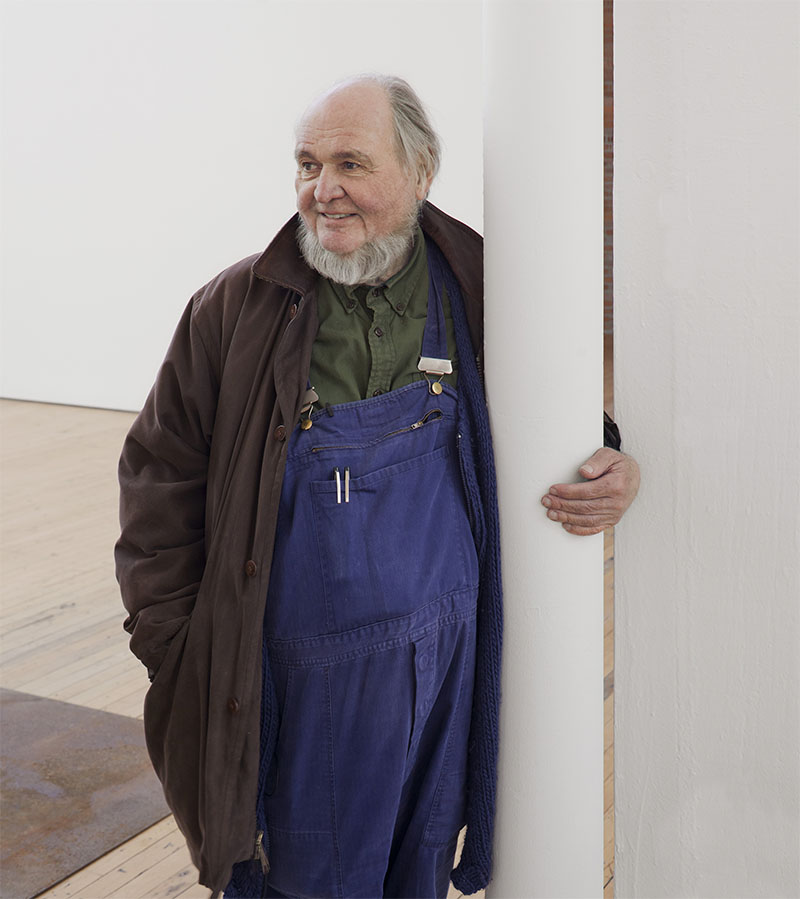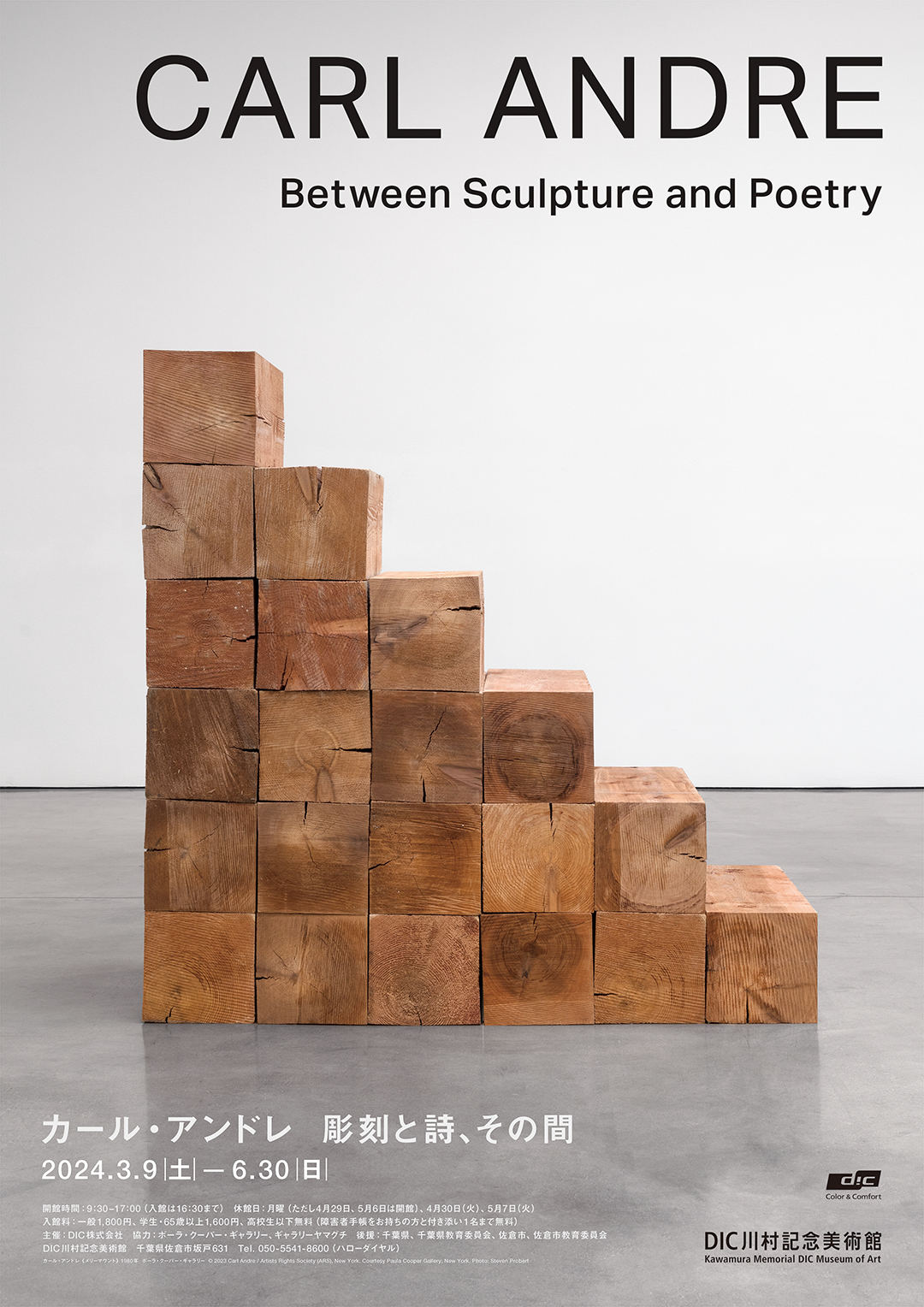Carl Andre
Between Sculpture and Poetry
March 9 - June 30, 2024
- Hours:
- 9:30-17:00 (last admission 16:30)
- Closed:
- Mondays (except Apr. 29, May 6), Apr. 30, May 7
- Organizer:
- DIC Corporation
- Special Cooperation:
- Paula Cooper Gallery, Gallery Yamaguchi kunst-bau
- In Association with:
- Chiba Prefecture, The Board of Education of Chiba Prefecture, Sakura City, The Board of Education of Sakura City
Carl Andre passed away on January 24, 2024 at the age of 88.
The Museum and staff members express our sincere condolences.
Museum Admission
Adults ¥1,800
College / 65 and over ¥1,600
HS students and under Free
| Museum Admission | Adults | College 65 and over |
HS students and under |
|||
|---|---|---|---|---|---|---|
| ¥1,800 | ¥1,600 | Free |
*Free admission for disability pass holders and one care-giver for each
*College students includes vocational and preparatory school students
*High school students include technical/vocational upper secondary school students
*For Student discounts please show a student ID, for Senior discount please show proof of age
*The permanent collection exhibition can also be viewed with a special exhibition ticket
Outline
Carl Andre (1935-2024) is one of the best-known sculptors of the Minimal Art movement, which emerged chiefly in the United States in the late 1960s. Between Sculpture and Poetry is Andre’s first solo exhibition in a Japanese museum. It makes full of use of its spacious venue to showcase Andre’s well-known sculptures made of blocks of wood, plates of metal, and slabs of stone processed to the same size and shape and placed in regular arrangements directly on the floor. In light of the way they act on the space in which they are installed, the artist describes these works using the term “sculpture as place.”
To view these sculptures in person reveals details that bely the regimented, inorganic impression they make: the way the metal gleams or rusts, the grain of the wood, the heft of the stone—the composed self-possession of matter itself. It also becomes apparent that not all of the units share the exact same size or shape.
Between Sculpture and Poetry also includes a selection of Andre’s poetry, which is evaluated highly by those familiar with it. Andre creates his poems by typing verbal fragments on a typewriter, and the results can be appreciated both as literature and as visual arrangements. Along with the spatial and structural awareness also evident in Andre’s sculpture, they reflect his thinking in a wide range of fields, including literature, art, history, and politics.
We invite visitors to Between Sculpture and Poetry to enjoy its presentation of Andre’s work in these two widely divergent forms.
Note: Between Sculpture and Poetry is an international traveling exhibition previously held at the Daegu Art Museum in South Korea from September 26 to December 31, 2023, under the title 2023 Umi Hall Project Carl Andre.
Biography

Carl Andre. photo:
Bill Jacobson Studio, New York, courtesy Dia Art Foundation, New York
Carl Andre was born in 1935 in the industrial city of Quincy, Massachusetts. He took an early interest in poetry that was shared by his parents. After studying at the prestigious Philips Academy, Andover, he spent time in Europe and the US Army before moving to New York in 1957 and taking a job at a publishing house. The following year, he began to share studio space with Frank Stella and began creating sculptures of wooden beams with cuts chiseled into them, influenced by Constantin Brancusi. Starting in 1960, he spent four years working as a brakeman for the Pennsylvania Railroad while writing poetry and working his Element series of sculptures created by combining units of wood. In 1964 he showed his work publicly for the first time at a group exhibition, and the following year held a solo exhibition at the Tibor de Nagy Gallery. At the Primary Structures exhibition in 1966, he showed Lever, a work made of 137 bricks arranged in a straight line. Shortly after this, he began assembling sculptures from rectangular metal plates placed directly on the floor and exhibiting a range of works at venues in the United States and Europe, each created on a scale appropriate to the venue. In 1970 he visited Japan as a guest artist at the 10th Tokyo Biennale. His major exhibitions have included a 1970 solo exhibition at the Guggenheim, where he first showed 37th Piece of Work; the 1996 exhibition Carl Andre Sculptor 1996, and 2014’s Sculpture as Place 1958–2010. He died in New York on January 24, 2024.
Events
Gallery Talk by the Guest
Motohiro Tomii (Artist)
Saturday, March 9, 11:30-12:30
- Booking required on the day of your visit at the Museum’s reception desk.
Cross Talk
Gen Umezu (Art scientist) × Takayuki Hayashi (Art critic)
Saturday, May 11, 13:30-15:00
- Prebooking required
Performance
Tamaki Roy (Rap musician)
Friday, April 12, 16:00-16:30
- No reservation is required
Haiku Gathering Workshop
Nobuhiro Yamaguchi (Graphic designer, member of haiku society 'Sawa')
Saturday, June 8, 13:30-15:30
Suitable for elementary school students and above
- Prebooking required
Gallery Talks by the Curator
Saturday, March 16
Saturday, April 20
Friday, May 17
Friday, June 14
Each day from 11:30-12:30
- Booking required on the day of your visit at the Museum’s reception desk.
Guided Tours
Daily, 14:00-15:00
- Booking required on the day of your visit at the Museum’s reception desk.
